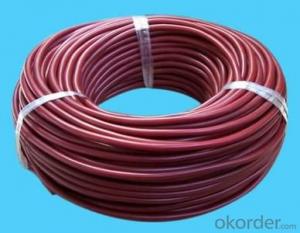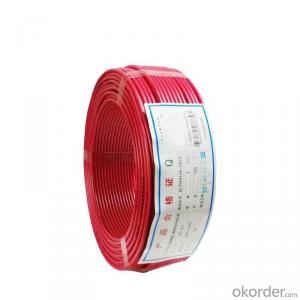Cu/PVC Flexible Copper Conductor PVC Insulated Eletric Wire 450/750V BVR 1.0 1.5 2.5 4.0
- Loading Port:
- Tianjin
- Payment Terms:
- TT OR LC
- Min Order Qty:
- 100 reel
- Supply Capability:
- 10000 reel/month
OKorder Service Pledge
OKorder Financial Service
You Might Also Like
BVR Cu/PVC JB/T8734
Conductor
Plain annealedcopper, Class 2 stranded circular or compacted
Insulation
Polyvinyl chloride(PVC)
Compound type C
Insulation color:
Green, yellow/green, red, yellow, blue,
Temperature rating
Maximum 70ºC
Rated voltage
450/750 V
Application
Suitable for power installations, household appliances,instrumentation and communication devices
a. Use as home appliance wiring cable, building wire
b. Use as electrical and electronic equipment internal connecting wire
c. Use as lighting wire
d. House wiring cable
| Type | No. of Cores | Corss Area ( mm2) | NO.of wire & diameter | Insulation thickness mm | Outer diameter mm | Weight kg/km |
| BV Cu/PVC -Solid | 1 | 1 | 1/1.13 | 0.7 | 15.73 | |
| 1 | 1.5 | 1/1.38 | 0.7 | 22.12 | ||
| 1 | 2.5 | 1/1.78 | 0.8 | 32.75 | ||
| 1 | 4 | 1/2.25 | 0.8 | 48.73 | ||
| 1 | 6 | 1/2.76 | 0.8 | 69.15 | ||
| BVR Cu/PVC-Strand | 1 | 1 | 7/0.43 | 0.7 | 16.9 | |
| 1 | 1.5 | 7/0.52 | 0.7 | 22.71 | ||
| 1 | 2.5 | 19/0.41 | 0.8 | 34.21 | ||
| 1 | 4 | 19/0.52 | 0.8 | 49 | ||
| 1 | 6 | 19/0.63 | 0.8 | 70.9 | ||
| RVV Cu/PVC/PVC -Flexible | 2 | 1 | 32/0.2 | 0.7 | 52.3 | |
| 2 | 1.5 | 48/0.2 | 0.7 | 70.45 | ||
| 2 | 2.5 | 78/0.2 | 0.8 | 103.75 | ||
| 2 | 4 | 127/0.2 | 0.8 | 147.2 | ||
| 3 | 1 | 32/0.2 | 0.7 | 96.45 | ||
| 3 | 1.5 | 48/0.2 | 0.7 | 133.73 | ||
| 3 | 2.5 | 78/0.2 | 0.8 | 180.63 | ||
| RVS Cu/PVC/ -Flexible | 2 | 0.75 | 37/0.16 | 0.7 | 29.73 | |
| 2 | 1 | 32/0.2 | 0.7 | 36.8 | ||
| 2 | 1.5 | 48/0.2 | 0.7 | 47.45 | ||
| 2 | 2.5 | 78/0.2 | 0.8 | 70.25 |

- Q: Everytime we leave the bedroom light on for too long ( say 30 minutes or more ), I open the door to the faint smell of something that resembles burning rubber and it gives me a headache. Is my wiring burning, the ceiling fan going bad or what?
- Seems to indicate some faulty wiring. An electrician should be able to do a resistance check on that circuit. There is an outside chance that it is the heat from the lamp. Replace it with an energy saver lamp as these run cooler.
- Q: The power of the line from the power of some then the current through the wire voltage will come down? Will this be more costly? Question added: is the wire and the voltage is not more than the cable
- Wire and cable industry belongs to the mechanical department, machinery manufacturing industry
- Q: I need to melt fishing line with the resistance in an electrical wire powered by a 9 volt battery. how do i go about this safely??
- The smaller the diameter of the wire, the higher it's resistance will be - it's the resistance to current flow that creates heat - as well as the amount of current flow. But batteries have their own internal resistance - a large current flow out of a small battery will mostly heat the battery. If you can use resistance wire (specially made to have resistance - get some out of an old toaster, or a power resistor, or light bulb filament), that would help. If not, use the smallest diameter of steel wire you can get. You could avoid the batteries internal resistance problem by using the battery to charge a capacitor , with a resistor in circuit so that the battery voltage stays high (internal resistance is why battery voltage falls off under load). once cap is charged, It can rapidly discharge the current all at once. Use a large capacitor with a voltage rating not too much greater than 9volt. Keeping the heat concentrated will be important. maybe have your wire and fishing line on top of one brick, and cover it with another. Prewarm the bricks as much as you're allowed (light bulb?)
- Q: I have strange wiring in my bathroom that I am trying to figure out and get working again. I have a two conductor with ground going into my fixture carrying the feed, then a three conductor with ground going to the switch. From the switch, there is a black wire jumped to the switch beside it(for the fan), then to the receptacle beside that. The white from the 3 conductor is going into the receptacle, the red and black into the switch for the light. Then there is a two conductor for the fan, with the black to the fan switch and a white to the receptacle. I have changed the two switches and matched them exactly as they were before, and changed the receptacle for a GFI. I neglected to write down how it is connected at the light fixture, so I am afraid to connect it wrong at that point. What is the correct way to hook this up?
- I bought a book called Wiring: Complete Projects for the Home by Creative Homeowner. I got it for $5.00. It goes through all sorts of different scenarios and how on the same run you can have two wire and three wire connections. I think it'd be a big help for your current and future projects.
- Q: I am removing a buried junction box. The feed wire is still present but I don't have the new junction box ready. Can I put a wire nut on and electrical tape until I get my supplies?
- The vinyl (PVC) electrical tape is outdoor rugged and waterproof. This would work well as a temporary junction when used in conjunction with a wire nut. It is commonly done as a temporary. Be a little generous with the tape.
- Q: Hi,If you were to wire up this motor, how do you go about doing that? To connect it to the mains for example.
- There are 5 or 6 11966 motors ranging from 1.5VDC, 1 Watt to 12VDC 20 Watts. These motors are normally powered by flashlight (torch) cells and not 220VAC. Adapters and approved, rectifying power supplies are probably available from the same source. You can wire these motors any way you wish if you confine yourself to flashlight cells, and approved power supplies.
- Q: I had a space heater on in a bedroom. I know, dumb idea, but it was plugged in to a power strip, which was plugged into a standard outlet. It was on for about 30 minutes. Then, it just shut off. I thought nothing of it, but when i unplugged the heater and later tried to plug other things into the power strip, the light on the power strip was on (the one that is always on if the strip is getting power), but nothing plugged in would work, even after resetting it. My house s circuit breaker did not trip. After unplugging the power strip, the outlet still works if I plug somethig in. This is probably insanely paranoid of me, but could this cause damage to my home s electrical wiring? Could this cause an electrical fire after everything has been unplugged?Thank you.
- Yes space heaters can. it isn't common but may be possible. Surge protectors aren't extention cords they are a device to protect electronic devices from an electrical over charge or surge. So under high wattage use will fry the electrical connections in the protector. That's probably what happened here. Other times they can catch fire and maybe a small explosion. The largest electric space heaters are around 1500w and draw about 12 amps. Most home outlets are rated at 15A or even 20A. So in good working order most heaters won't hurt an outlet or wiring if that is the only thing on that breaker. If things do go higher the breaker should trip and cut power. If the breaker is old or damaged it may not trip and then somethings gotta give next either the outlet or the wiring normally it's the plug but if two things on two plugs the wire may catch fire. also don't use cheap extention cords they will catch fire you can use extention cords but rated at least 14G for 15A or 12G for 20A.
- Q: Wire and cable countries do not have a few meters?
- In general, the choice of how much wire and voltage relationship is not great, mainly to see the current, the voltage is only that the insulation layer of the insulation level, the general wire can be achieved, so do not consider, 16A current can Select 2.5 square millimeters of copper wire, which is the national standard, 2.5 square copper wire allows long-term load current: 16A - 25A
- Q: My family is this year's new cover of the color steel room, used in the old house when they are relatively thin wires, electricity is very normal every month, but a move to a new house when the electricity that month A bit too much, or the same electricity habits or those appliances how the monthly electricity will be so much? Where is the place where there is leakage and our home with a rough relationship between the wire? Just try to use a pen, and some places are 12v some places did not show, please know how to help my friends how to analyze ah? Thank you! More
- Plastic pipe, plastic pipe, plastic pipe, plastic pipe, plastic pipe, plastic pipe, plastic pipe, plastic pipe, plastic pipe, air conditioner, plastic pipe, plastic pipe, plastic pipe, plastic pipe, plastic pipe , Also includes a plastic wire tube that wears a wire. The plastic pipe that wears the wire can not replace the plastic pipe. But the plastic pipe can replace the plastic pipe through the wire.
- Q: I had work in electrical business for about 10 years! I had my company overseas and I had a lot of projects done as well as building electric of a Mall! My question is what paperwork do I need, how long the procedure takes to obtain all the certificates and register company, how much would I need to invest and are there any big electric company that can offer me work and support as subcontractor in NJ or NY state!Thank you very much for your time!
- Contact the website below to get an answer to what training and testing you will need for each category of electrician in New York.
Send your message to us
Cu/PVC Flexible Copper Conductor PVC Insulated Eletric Wire 450/750V BVR 1.0 1.5 2.5 4.0
- Loading Port:
- Tianjin
- Payment Terms:
- TT OR LC
- Min Order Qty:
- 100 reel
- Supply Capability:
- 10000 reel/month
OKorder Service Pledge
OKorder Financial Service
Similar products
Hot products
Hot Searches




























